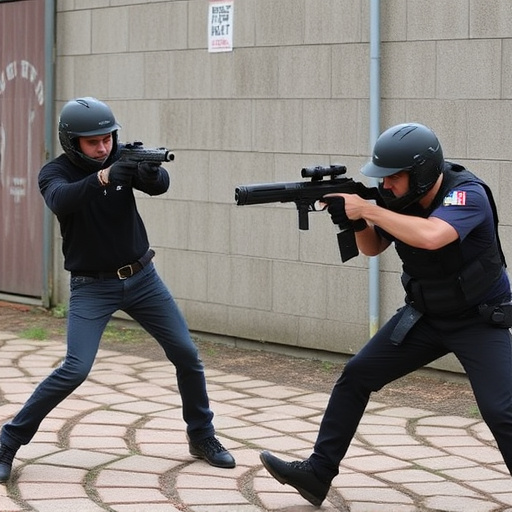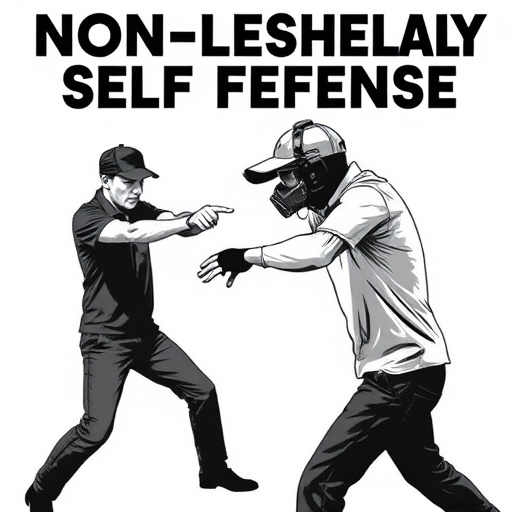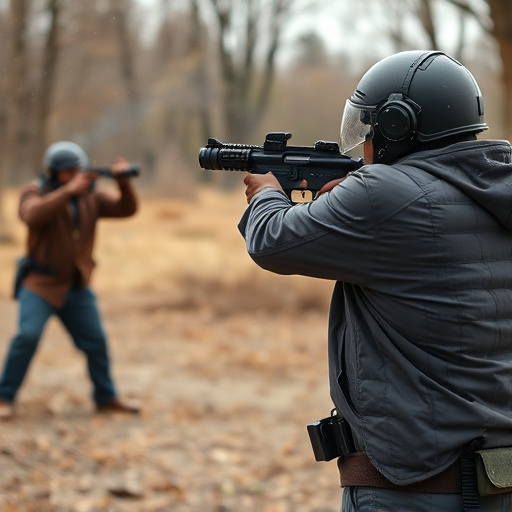This text compares tasers and stun guns, focusing on their suitability for apartment living. Stun guns are preferable due to faster activation times and no-contact requirements. When selecting a stun gun, consider size, weight, ease of use, powerful jolts, and modern features like LED lights for close quarters. Tasers, though powerful, require training, disrupt muscle control over a 15-20 foot range, and are better suited to open spaces. For apartment dwellers, the ideal stun gun offers peace of mind, effective immobilization without severe harm, durability, and versatility in various scenarios, with an emphasis on informed, researched choices for personal safety, specifically focusing on the best stun guns for apartment living.
“In today’s world, knowing how to protect yourself is essential, especially in close quarters like apartments. Tasers and stun guns, both popular self-defense tools, offer distinct capabilities. This article guides you through the nuances of these devices, focusing on their unique features and ideal use cases.
We’ll explore the ‘Understanding Tasers and Stun Guns’ to uncover key differences, delve into ‘Stun Guns for Apartment Living’ considering safety and effectiveness, compare ‘Taser vs. Stun Gun’ power and range, and provide a ‘Comprehensive Analysis’ to help you choose the best stun gun for apartment living.”
- Understanding Tasers and Stun Guns: Unlocking the Key Differences
- Stun Guns for Apartment Living: Safety and Effectiveness Considerations
- Taser vs. Stun Gun: Power, Range, and Safety Features Compared
- Choosing the Right Self-Defense Tool: A Comprehensive Analysis
Understanding Tasers and Stun Guns: Unlocking the Key Differences

Understanding Tasers and Stun Guns: Unlocking the Key Differences
Tasers and stun guns are both non-lethal weapons designed to incapacitate an individual, but they function differently. A taser, short for “thauter electro-muscular disruption device,” uses electrical current to disrupt muscle control, causing the target to fall to the ground temporarily. These devices are often used by law enforcement and require physical contact or a focused beam to deliver a shock. In contrast, stun guns, also known as electronic control devices (ECDs), use high-voltage, low-current electricity to overload the nervous system, leading to temporary disorientation and immobility. Stun guns can be more suitable for apartment living among best stun guns options, as they typically require no physical contact and offer a faster activation time compared to tasers.
When considering the best stun guns for apartment living, factors like size, weight, and ease of use are paramount. Smaller, more compact stun guns are ideal for tight spaces and discreet carry. Lightweight models are easier to handle during emergencies without becoming cumbersome. Additionally, features like simple activation mechanisms and powerful jolts ensure effectiveness in close quarters. Understanding these key differences between tasers and stun guns can help individuals make informed decisions when selecting a suitable personal safety device for their specific needs, especially in urban or apartment environments.
Stun Guns for Apartment Living: Safety and Effectiveness Considerations

When considering self-defense options for apartment living, stun guns offer a unique balance between safety and effectiveness. Their non-lethal force makes them an appealing choice for urban dwellers who want to deter potential intruders without causing severe harm. However, not all stun guns are created equal; for apartment settings, specific features matter.
The best stun guns for apartment living should prioritize ease of use, compact size, and robust power output. A user-friendly design ensures quick deployment during unexpected situations. Additionally, a smaller, lightweight model is ideal for navigating narrow spaces within an apartment while still providing enough force to disable an attacker temporarily. Many modern stun guns also incorporate LED lights or laser pointers, enhancing their effectiveness in low-light conditions common in apartments.
Taser vs. Stun Gun: Power, Range, and Safety Features Compared

When comparing Tasers and stun guns, understanding their power, range, and safety features is crucial for making an informed decision, especially when considering the best stun guns for apartment living. Tasers, officially known as Conductivity Enforcement Devices (CEDs), use electrical current to disrupt muscle control, rendering the target temporarily incapacitated. They are generally more powerful than stun guns, with a typical range of 15-20 feet. However, Tasers fire two probes connected to wire cords, which can limit their effectiveness in close quarters and increase the risk of probe retention, requiring proper training to avoid.
Stun guns, on the other hand, use high-voltage, low-current electrical pulses to overwhelm the nervous system. They offer a shorter effective range of around 5-10 feet but do not have the same issues with probe retention as Tasers. Stun guns are often smaller and easier to conceal, making them more suitable for apartment living where space is limited. Their safety features include simple activation mechanisms, reducing the learning curve and increasing likelihood of proper usage in emergency situations.
Choosing the Right Self-Defense Tool: A Comprehensive Analysis

Choosing the right self-defense tool is crucial, especially in situations like apartment living where space and safety are paramount. When it comes to personal protection, Tasers and stun guns are often considered, but they serve different purposes and have distinct advantages. For those seeking the best stun guns for apartment living, several factors come into play. First, size and portability matter; a compact, easy-to-carry device can provide peace of mind in close quarters. Second, power output is essential—a high voltage stun gun ensures effective immobilization without causing permanent harm, which is especially important in shared living spaces to avoid accidental injuries.
Moreover, durability and reliability are key; a well-built stun gun designed for indoor use should withstand regular handling and potentially challenging conditions. Water resistance and a robust design can ensure it remains functional during unexpected incidents. Additionally, features like LED flashlights or multiple firing modes offer versatility, allowing users to adapt to various self-defense scenarios. Remember, the best tool is one that gives you confidence and meets your specific needs, making informed choices based on research is essential for effective personal safety.
When it comes to choosing between a taser and a stun gun, understanding their distinct features is key. For those seeking options suitable for apartment living, stun guns often prove more practical due to their shorter range and less disruptive impact. While tasers offer greater power and range, they may not be as discreet or effective in controlled indoor environments. Ultimately, the best self-defense tool depends on individual needs, with stun guns emerging as a top choice for apartment dwellers looking for safety without causing widespread alarm. In selecting a stun gun, prioritize quality, reliability, and ease of use to ensure you’re prepared should the need arise.
